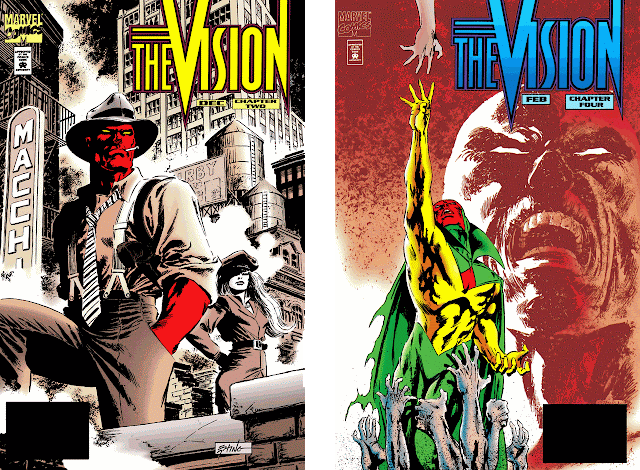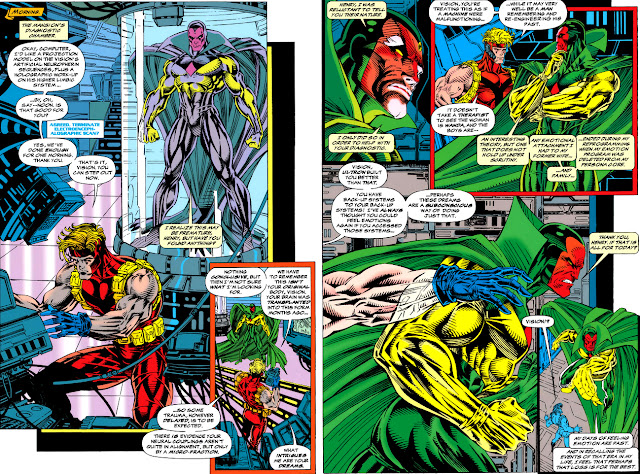OR: "The Vision, P.I."
Recently we've taken a look at the story of the Lipton family, whose paths first crossed with the Avenger known as the Vision in 1991 when, in the emotionless, pale form he occupied for a four-year period, he approached researcher Miles Lipton in an effort to seek out some purpose to his existence. Sometime afterward, his ties to the Liptons appeared to come to an end in a touching story by writer Bob Harras which saw Miles pass away after a battle with cancer as the Vision continued to struggle with his lack of emotion.
While in the company of Miles, however, the Vision, destabilizing due to a lack of third-party brain patterns following his reprogramming, received the recorded engrams of Miles' deceased son, Alex.
(Harras is incorrect here in stating his son's occupation as a police officer; Alex Lipton was killed while employed at Roxxon in their R&D division, with no indication that he was working in an undercover capacity. Unfortunately, Alex's "background as a cop" will be a key factor in how Harras resolves the Vision's predicament in this story.)
Nearly a year later, as the Avengers battled the threat of the Gatherers, the Vision would be captured and subsequently find his android mind physically switched with that of a more ruthless Vision from an alternate reality; but later, the Avengers discovered that Vision's duplicity and confronted the Gatherers in a fierce battle where the true Vision was freed, while his evil doppelganger presumably met his end. Which finally brings us to late 1994, as Harras features the Vision in a four-issue series which sees the return of the Gatherers, the return of Ultron, and, perhaps, a new beginning as far as the Vision's emotional awareness finally being reaped.
The running theme of the series has to do with the Vision having disturbing dreams of his former wife, the Scarlet Witch, and their two sons (since found to be a figment of Wanda's imagination given form)--something which shouldn't be likely, given his utter lack of emotion. To discern their true nature, he approaches Henry Pym, an expert on the Vision's physiology--whose opinion on the subject, given the absence of any evidence of an outside threat, is fairly reasonable, except in one respect.
Naturally, the Vision had dealt handily with our muggers at the docks before returning to Avengers Mansion, after having discovered that he'd been followed there by Deathcry, a guest of the Avengers, who had become fascinated with his nightly excursions there. As to the cause of his dreams, Pym may be proceeding from an incorrect assumption, in that there is no way to know if Ultron--that is to say, the Ultron of an alternate world--was the creator of the Gatherer-Vision... though for our purposes here it's a non-issue.
But speaking of Ultron, the Vision responds to a signal sent from the French quarter of New Orleans, from a source which seems a likely if inebriated suspect to him for these sudden dreams that have manifested.
As is evident, the story's art by Manny Clark is typical of Marvel's books from the mid-'90s, replete with half- to full-page scenes (and certainly two-page spreads) where characters appear larger than life in more than the heroic sense. Such a format would no doubt require some adaptation by both writer and artist when plotting a monthly story, given a limited page count of 22-23 pages in which to work. For an annual, scenes taking up so much space per page might be ideal; here, you may find that in a limited series, where a character is pursuing the answer to a single mystery, Harras and Clark have managed to find a form of storytelling which covers the bases they need to in a span of four issues.
Ultron goes on to tell the Vision that his "infection" is going to result in an influx of human emotion that will overwhelm him, before inadvertently (thanks to the interference of a rash bar owner) felling him with twin energy beams and then departing. When the Vision wakes, this mystery has taken a turn that, at first glance, he appears more than willing to accept.
To make matters even more strange (and that's saying something), this is a Jocasta from an alternate timeline, which would suggest the Gatherers have made their move--yet Jocasta seems as infected as the Vision, whose memories are as twisted as hers and who now believes that he's a private investigator named Simon Williams.
As we see, two of the Vision's associates from the Avengers, Deathcry and Crystal, have come in search of him--but when they broach the subject of the Vision's dreams, he lashes out at them, only to collapse in mental agony. When he regains consciousness, he is the Vision once more, leading to the group then going over events in an attempt to understand what's going on (all except Jocasta, who is still embracing her current identity and readily admits to liking this life that's been forced upon her). But before all of them can return to Avengers Mansion in order to begin tracking down the culprit or culprits responsible, another player in this drama arrives in the form of Tabula Rasa, an android once in the service of the Gatherers, who has brought the captured Ultron with him. The encounter has the effect of reverting the Vision to his hostile state toward Crystal and Deathcry, the latter of whom is captured by Rasa.
When the dust settles, all the reader knows is that the Vision has gone off on his own, while Deathcry and Jocasta are now sharing a holding cell with Ultron. As for Crystal, she has brought help in searching for the Vision, who has since sought out a woman from his past--but, eerily, not as himself.
(How clever of Clark to utilize a full page for one of the scenes above by turning what would otherwise be a horizontal layout a full ninety degrees.)
Meanwhile, Deathcry and her fellow captives are being introduced to the architect of this plan--the same Vision who was thought destroyed in the raid on the Gatherers' citadel. In that plan, it seems that the emotional infections of Jocasta and Ultron were just a means to an end.
And things couldn't be going better for that plan, as, back on Long Island, the Vision (our Vision, that is), his mind becoming further unhinged from his double's insidious program, escapes from the custody of Pym and Crystal and joins the former Gatherer and his android puppet, Tabula Rasa.
What the "anti-Vision" discovers, however, is that the Vision continues to fight the program affecting him--but what he doesn't realize is that the Vision is being aided by the parts of his mind based on what's left of the brain engrams of both Alex Lipton and Simon Williams (to which even the Vision expresses surprise, since all vestiges of Williams were believed to have been wiped when the Vision was disassembled and reprogrammed). Together, both "Alex" and "Simon" explain in detail how his dreams of Wanda and his sons were being used to act as a final trigger for the program which would erase any traces of himself and thus clear the way for the anti-Vision's takeover.
That information, in addition to learning that his double is now on the verge of killing Deathcry, serves to give the Vision the strength of will to overcome his foe's program--and while Ultron attacks Rasa, the Vision and the one who would reclaim his body battle for the right to possess it.
It is not an easy victory for the Vision, given how his foe has denigrated and used him--to the point of the Vision continuing to attack with the intent of destroying him utterly, stopped only by the pleading of his comrades to relent. In the aftermath, we learn that the Vision has been changed by the inner struggle he went through--and what those changes will mean for him as the Vision, and as an Avenger, will only be discovered with time to himself and those left in this struggle's wake.
All right, so there's no way the Vision can glide away like a wraith while holding one of the heavyweights he's hoisting, let alone two. How about a single panel of the three walking away together down a shadowed street as a farewell scene, instead? (Probably rejected because it wouldn't have filled up an entire page, but what do I know.)




















4 comments:
The Steve Epting covers for that Vision series were things of beauty. Unfortunately I don't feel the same way about the interior art! If I had to sum up the mini, I'd say its more interesting than entertaining.
I can't help but agree with you on both points, Dave, though I did find myself enjoying the story as a whole. (Even its bizarre twists and turns--I must admit that I never saw a drunk Ultron coming, in any scenario. Exactly how does one inebriate a walking atomic reactor?)
Have to second Dave's comments on the art. For the 1990s it has that 1980s Image comics look which I never liked. Great covers but Clark and Machlans interior art doesn't do it for me, neither does the "new" Visions costume.
To be fair (and if I remember correctly) the artist does throw in a lovely little touch: when Ultron is drinking, all the ale just pours out of the sides of his mouth!
Post a Comment